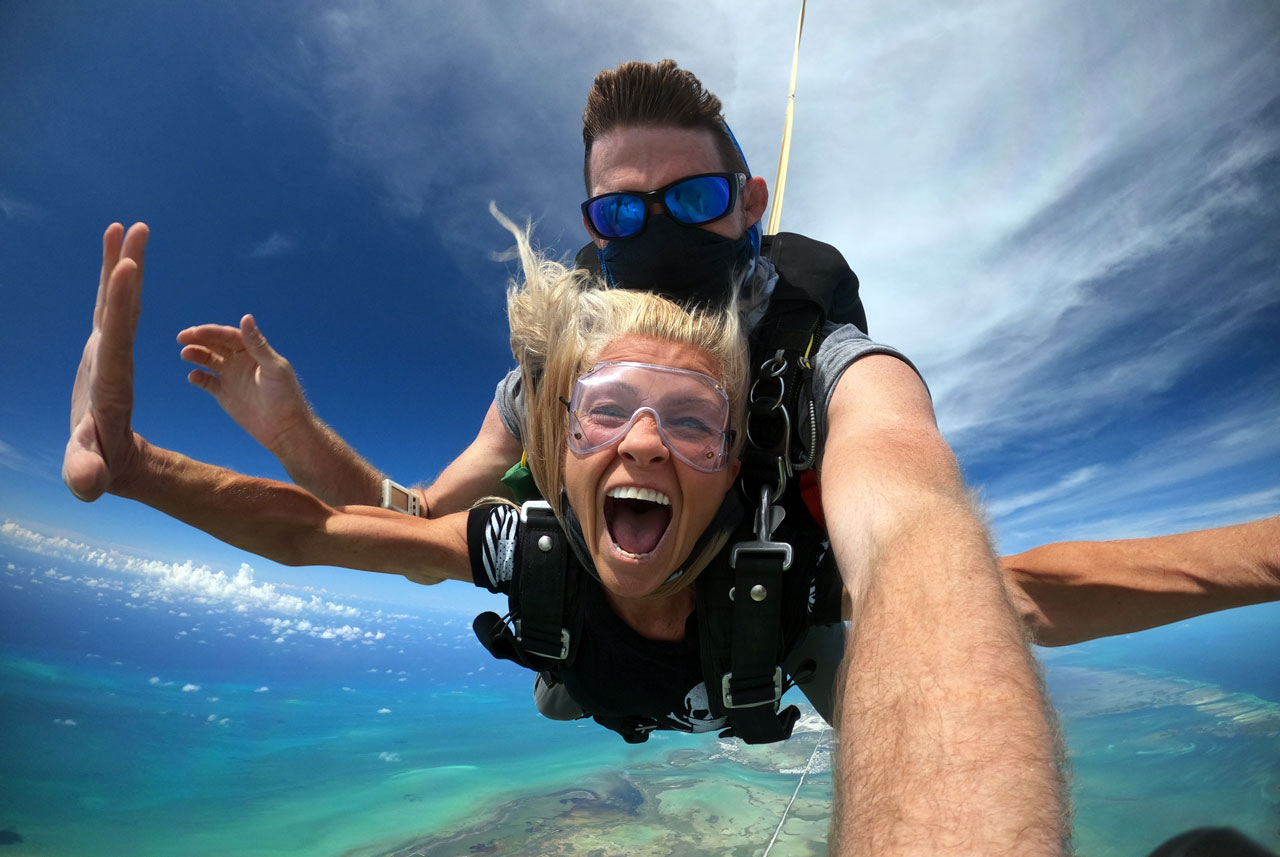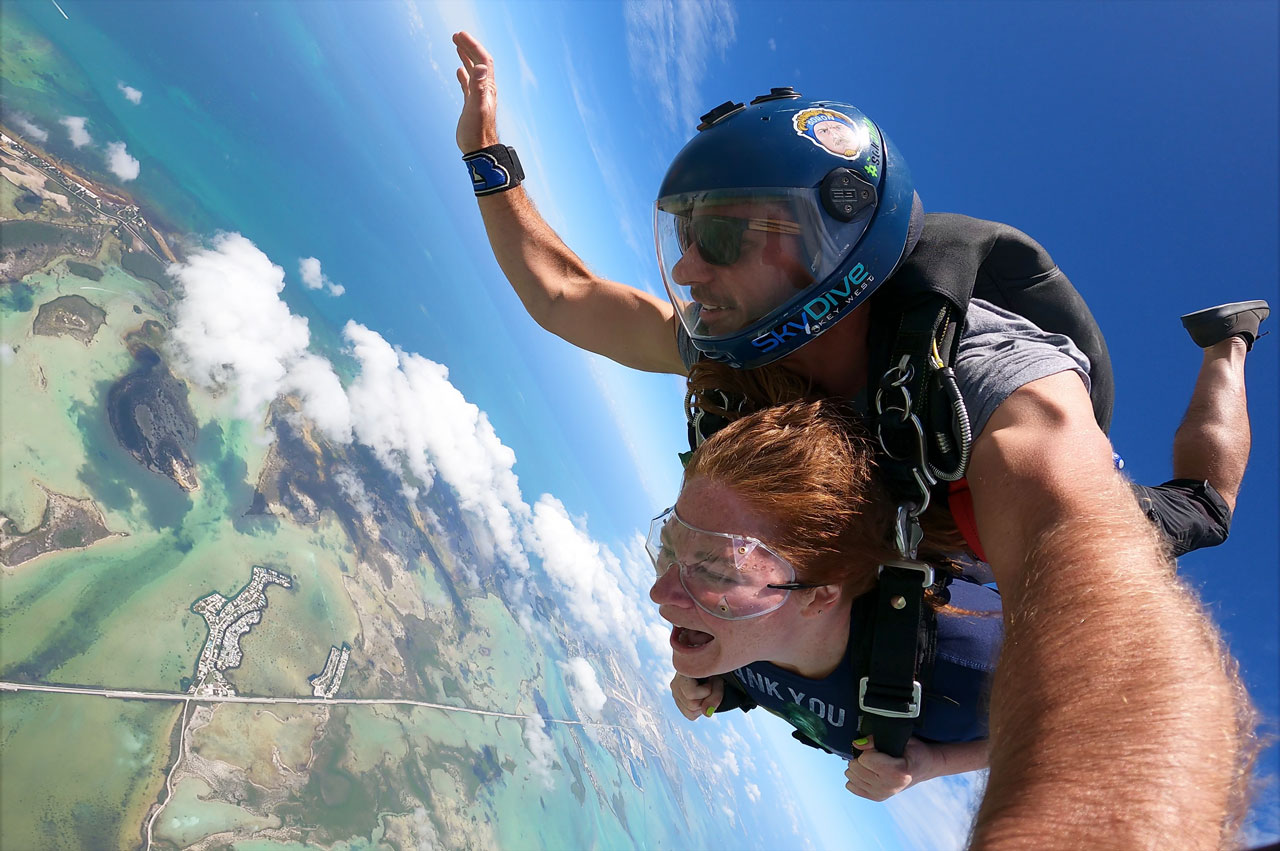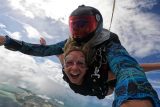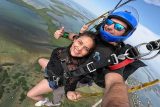How Fast Do You Fall When Skydiving?
Skydiving
Posted by: Skydive Key West
2 years ago
If you’ve ever asked “how fast does a skydiver fall?” you may have been told in response: “terminal velocity.” But what even is terminal velocity? Well, you may be surprised to learn that it’s different for everyone and is dependent upon a few different factors. However, a rough average for skydiving freefall speed on your belly is 120mph. Let’s jump into the technicalities of skydiving speed!

How Fast is Skydiving?
Terminal velocity is the maximum velocity (speed) attainable by an object (you) as it falls through the sky. Since we are not skydiving in space (yet!) and have to deal with the constant force of gravity, there are many different factors like weight, density, drag, and shape (also known as body position) that determine an individual skydiver’s distinctive maximum speed.
Think of it this way … you drop a coin and a feather from the same height at the same time. The feather would obviously take longer to hit the ground than the coin. Now, say we add some fabric around the coin creating drag and slowing it down; this allows the fall rate difference between the coin and feather to be slightly decreased. If we added a lot more drag and somehow altered the shape of the coin and feather, it’s possible that they would fall the same speed. This same principle is how skydivers of all different shapes and sizes are able alter their fall rates to soar through the skies together!
Orientation Matters
Changes in your body orientation during a skydive will adjust your freefall speed. When a skydiver decreases the surface area presented to the wind, their speed increases. And vise versa.
Think about the classic belly-to-earth, arched freefall position – kind of banana-shaped! This position takes up a significant amount of surface area and yields a slower fall rate than a more aerodynamic posture. If someone is skydiving in a seated position, they’ll be going faster than the belly person … and if someone is flying head-down, they’ll be zoomin’ through the air faster than both! Sit flying and head-down are both body orientations used in free-flying.
DRAG
In skydiving, drag usually refers to what someone chooses to wear in order to speed up or slow down on a jump.
Let’s say there are two people who want to skydive (belly-to-earth position) together, one of them weighs 220lbs and one weighs 120lbs. Body position might not be enough to make up for the difference in fall rates. The 120lb person may need to decrease their drag by wearing something tight fitting, allowing them to fall faster … while the 220lb person will need to increase their drag and wear a looser-fitting jumpsuit (allowing them to fall more slowly).
What in the World is a Drogue?
Have you ever seen a photo of a tandem skydive and, while in freefall, the tandem pair has a thing that looks like a mini-parachute about 20 feet above them? This is called a drogue and it has two purposes: slowing the fall rate and increasing stability.
The terminal velocity of people doing a tandem skydive is much higher than a single jumper due to the extra weight and density. The drogue is used to slow down the skydivers in order to make it possible for them to get some sick pics and to have an ideal parachute deployment. The drogue ensures that the speed of the skydivers is not more than the parachute can withstand upon opening.

So, How Fast Does a Skydiver Fall with the Parachute Open?
Similar to the terminal velocity calculation addressed above, the speed (descent rate) while under the canopy, or wing, takes certain factors into account. These include the weight of the jumper compared to the size of the canopy (this is called wing-loading), as well as the shape and flight characteristics of the canopy. Some wings are designed to dive steeper and fly faster–these are advanced and used by people with hundreds or even thousands of jumps! Other canopies are designed to be more forgiving and are used by those who are still getting comfortable and confident in the air.
Let’s go back to the example of the feather and coin to address wing-loading. Both of them have jumped and are going to deploy their parachutes, the coin has a 210sqft canopy, and the feather has an 84sqft canopy. It’s possible the feather will actually make it down before the coin because it has a higher wing-loading!
What About Landing!?
Tandem canopies are designed to be docile and will have a vertical descent rate of about 15mph – give or take a little for the weight of the two jumpers.
So if you’re asking: “How hard is the skydiving landing?” it’s usually not hard at all! Landings have a bad reputation for causing soreness, but these are typically from the olden days when skydivers were jumping round parachutes. The Ram-Air rectangular canopies we now use allow for more maneuverability as well as soft and pleasant landings – just remember to listen to your instructor’s guidance so you know what to do to avoid an uncomfortable landing.
If you’re ready to put your skydiving speed to the test, witness world-class views, soar through the skies, and experience the thrill of a lifetime, then book your tandem today! Don’t hesitate to reach out with questions. We’re here to support your skydiving journey. Blue skies!




